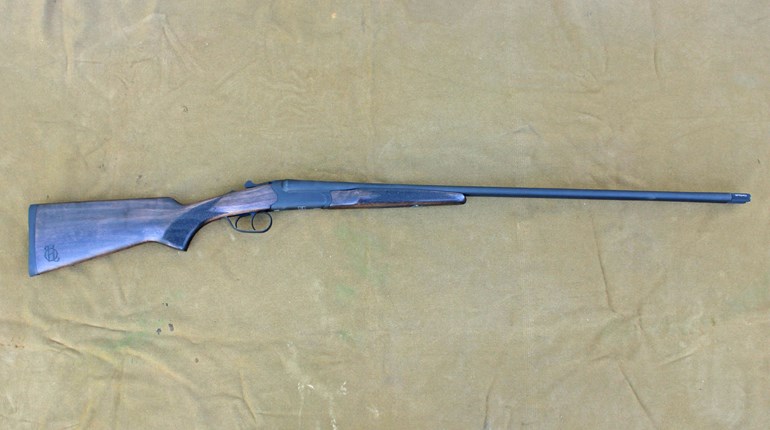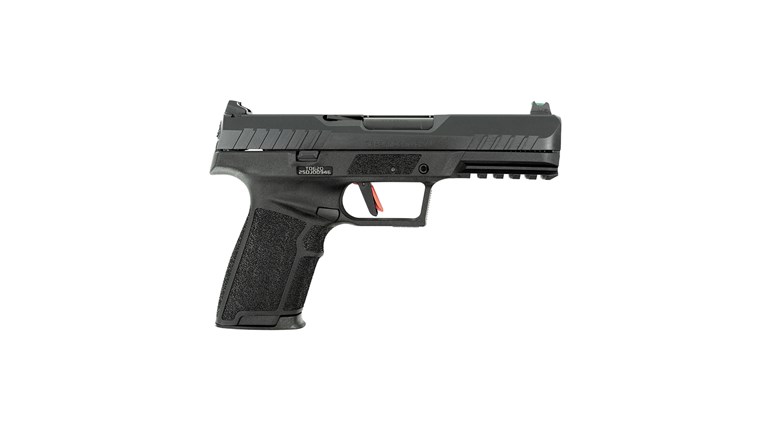
While the increasing trend the past few years has been to “tacticalize” the lever-action rifle with plastic stocks, Pic rails, M-LOK fore-ends, lasers and lights, Savage Arms decided to go retro with its new Revel Classic chambered in .22 Long Rifle. Redesigned with modern materials and a return to minimalism, the Revel melds the best of the old and new schools for students of the lever-action rifle. And it’s a slick, fun shooter.

Much about the Revel Classic will be familiar to shooters of lever-action .22s, including the 12-round tubular magazine, buttstock profile, classic barrel-mounted sights and lever loop enlarged to accommodate a gloved hand. Different is the medium-contour barrel, black matte finish, push-pin takedown and a smooth, streamlined receiver cover that’s drilled and tapped for scope mounting. Despite the differences, the Revel retains the look of classic lever-action .22s.
Buttstock and fore-end are Turkish walnut with just enough grain and a hint of figure to not be plain, stained a medium brown. Lightly textured, the plastic butt plate is perfectly fitted to the wood. The wrist is the classic straight style. The buttstock is contoured, from the top swelling outward to peak at about the halfway point, and then abruptly reversing to slim down again toward the bottom. In effect, the contour provides a bit of cheekpiece lacking in more traditional design. The fore-arm has a similar contour but the bottom is rounded and fills the hand much better than, say, a Winchester Model 9422, and yet without appearing bulky, like Marlin’s old “perchbelly” fore-end found on some Model 39s.

In a world where zinc alloy receivers and other parts define cheapness in a lever-action .22, the Revel’s quality is refreshing. All metal parts—barrel, magazine tube, lever, trigger, hammer, bolt, sights and fasteners—draw a magnet, indicating steel, except for the aluminum receiver and receiver cover. The latter’s matte black finish is a powder coating, while that on the barrel, magazine tube and other steel parts is black oxide.
Tapering from 0.770 inch at the breech end to 0.690 inch at the muzzle, the Revel’s hefty 18-inch medium weight barrel is immediately noticeable at first glance and is considerably beefier than typical sporter weight barrels of 0.550-inch diameter. The barrel’s weight puts the rifle’s balance point exactly at the front of the receiver, making the Revel an easy one-handed field carry. A slight dishing offers crown protection. A Lyman borecam showed nothing untoward in the bore, and a clean termination to rifling at the muzzle without nicks or burrs.
The receiver is noticeably a bit longer than one would expect for chambering the .22 Long Rifle cartridge. Measuring 1¾ inches long, the ejection port appears at first to provide more clearance for ejection of cartridge cases than other lever-action .22s. However, the ejector, a simple projection machined into the top of the feed throat, is located one inch—the length of a loaded .22 Long Rifle cartridge—back from the breech face, so the aft three-quarters of the ejection port is not needed, and the bolt continues travelling backward to clear the rear of the port. The most likely explanation is that, as Savage Arms will later introduce Revel rifles in .22 Magnum (and .17 HMR), the lengthened receiver and ejection port noted here will allow Savage to utilize the same receiver for all three cartridges.

Safety features include a half-cock notch on the hammer that adds redundancy to the crossbolt safety that has become a fixture on today’s lever-action rifles. With the crossbolt safety engaged, the lever throws only far enough to set the hammer at halfcock and cannot chamber a cartridge. A flat hammer spur with deep serrations provides positive control during thumb cocking and decocking.
(ALMOST) TOOLLESS TAKEDOWN
Two takedown pins and four hex head receiver cover screws are flush mounted in the receiver, adding smoothness to its already streamlined appearance. Savage Arms says takedown of the Revel is toolless, but for the sake of clarity, I would call it, “almost toolless.” For takedown, the two captive pins that affix upper barrel/receiver and lower action/buttstock halves together are pushed out from left to right; in order to start them so that they protrude far enough from the right side of the receiver to grasp and pull, a punch—even an ersatz punch, like the tip of a pen—is needed. I found that, perhaps not coincidentally, the takedown pins are the same diameter as a .22 Long Rifle cartridge, which makes an eminently handy and at-hand ersatz punch.

Takedown of this specific, brand-new rifle required that the tight-fitting front takedown pin be started with a brass punch and a light tap with a small mallet; this stiffness may loosen up after a period of usage. (Unlike so many lever-action rifles we’ve all handled, nothing on the Revel rattles when the rifle is shaken.) Once the two captive takedown pins are pushed out fully to the right, the rifle’s upper and lower halves (which are serial numbered to each other) can be separated. Fit of the two halves is snug, but not overly tight. The remainder of disassembly consists of turning out the four receiver cover screws to allow removal of the cover; this permits completely withdrawing the bolt so that the rifle can be cleaned from the breech end.
Savage Arms advises against any further disassembly, but with many years of experience repairing firearms, I found nothing particularly nonintuitive or tricky about delving into the Revel’s innards, the simplicity of which evokes a minimalist approach. Other than being serial numbered to match the receiver, the bolt holds no surprises, the firing pin, extractor and cartridge guide all retained with ordinary roll pins, and except for the hammer pivot pin, most of the rest of the Revel being held together with hex head screws. The owner’s manual includes a kind of block diagram “exploded view,” but it’s not a detailed schematic and doesn’t show the relationship of action, receiver or bolt parts. If you do go tinkering in there and get lost, you’re on your own, hence Savage’s advice.

EASY LEVER, LIGHT TRIGGER
After demonstrating its operation to her, I handed the unloaded Revel to a new (adult) shooter completely unfamiliar with lever-action rifles. She shouldered the Revel and cycled the lever a few times. “It’s so easy!” she exclaimed, “I love it!” Indeed, the Revel’s lever is so slick and operates with so little effort that it compares to smooth rack-and-pinion lever-action rifles like the Henry Long Ranger and the exquisite but long-gone Bullard. I can easily operate the Revel’s lever with one finger.
Savage Arms Rimfire Product Manager Brett McKenna attributes the slick, effortless operation to holding tight tolerances in the lever-bolt relationship to prevent binding, and proper torque on the pivot screw attaching lever to receiver. “If that screw is too tight it causes binding on the lever,” Brett said, “and if it’s too loose it causes slop in the lever.” As well, the lever throws nearly a full 90 degrees, compared to perhaps 45 to 60 degrees on other lever-action .22s, contributing leverage to that effortless cycling.

Augmenting the ease of lever operation, the factory trigger breaks at a light 2¼ to 2½ pounds. If not for considerable creep, it would be superb; still, it’s perhaps the lightest factory trigger I’ve experienced on a lever-action .22. The creep appears to be caused by the relationship of the sear (which is the top of the trigger) and hammer hook angles, and while slowly pressing the trigger, one can observe the hammer move slightly backward as the sear pushes upward on the hammer hook before releasing. While a gunsmith might be able to safely eliminate the creep, it is not a DIY job and, either way, the modification would void the factory warranty.
SMALL GAME ACCURACY
At this writing, Savage Arms was still working on manufacturing its own branded scope mount rail for the Revel, so I purchased a ready-to-go $40 ($55 with shipping) Picatinny rail to fit the rifle from EGW, which is apparently the only resource for a Revel mount of any kind at present. For accuracy testing, I mounted a BSA Sweet 22 3-7X scope and fired a variety of hunting ammunition through the Revel from a heavy rest at 25 yards. Variable winds on shooting day shied several groups a bit to the right, but the rifle showed excellent small game accuracy with virtually all brands of ammunition, consistently grouping five shots under an inch. CCI’s Suppressor Subsonic ammo shot exceptionally well, grouping less than a half-inch.

Savage Arms offers the Revel in two versions, the Classic presented here and the DLX, which for $100 more features a curved pistol grip, decorative carved slots and stippling of the wood, a soft rubber recoil pad and, on the rifle I fired at SHOT Show 2025, a threaded muzzle.

Savage manufactures the Revel in Lakefield, Ontario, Canada. MSRP for the Revel Classic is $439. Our government’s (proposed, at this writing) 25% tariff on goods imported from Canada will likely drive that price upward, so now may be a good time to purchase a pre-tariff rifle if you’re in the market for a quality .22 lever gun.
SHOOTING RESULTS

Learn more at savagearms.com.


































